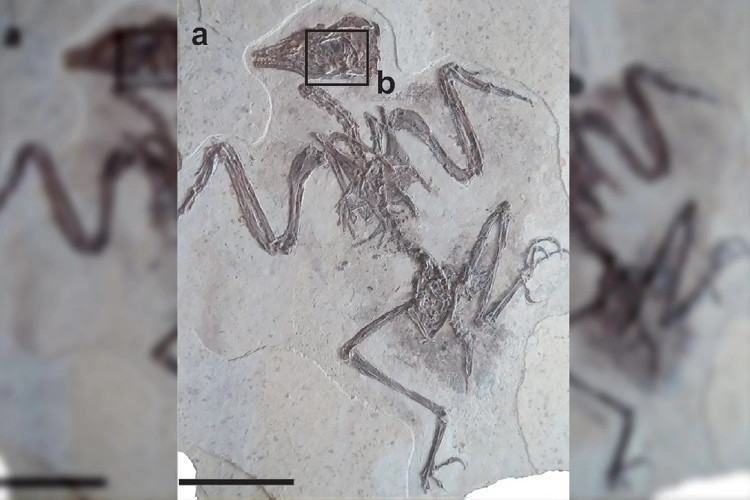The intact fossil after 120 million years reveals a mysterious loss of prehistoric animals
Recently, through a fossilized eye in an almost 'perfect' condition, Chinese scientists have found an unexpected secret about prehistoric birds and animals.
Around 2013 in Liaoning Province (China), a local collector found a fossil bird about 12 meters long, belonging to the modern house. This fossil record dates back to 120 million years, still enough neck, tail, nail and especially soft eye tissue - including cones and rod cells - in the 'perfect' fossil state . It is known that immediately after finding it, the collector collected it for the Shanghai Museum of Natural History.
'This is the first time in the world, 1 bird eye fossil remains intact soft tissue found', said Mr. Baochun Zhou - Associate Professor of Paleontology at the museum.

Ancient bird fossil samples were found in Liaoning (China).The black square shows an almost intact fossil position after 120 million years.
Like the human eye, the bird's eye also has cones and rods in the tissue that senses light at the back of the eye. However, birds still need an oil drop at the top of the color-sensing cone cells - playing a similar role to the color filter on camera lenses - to distinguish colors. For example, to feel red, the bird's brain will order the release of red oil droplets into red-colored cone cells, helping the bird's eye recognize this color.
For a long time, scientists often speculate that the optical system of cones, which is very complex, appears only in birds and other modern animals, meaning birds and ancient animals seem to be color blind?
However, after a great deal of research, scientists have finally found a secret that can reveal an important part of history in Paleontology. Accordingly, under electron microscopy, oil droplets in fossilized soft tissue are about the same size as modern birds.

Enlarge image of fossil eye samples.
'Perhaps, this extinct bird is an animal during the day and has the ability to distinguish different colors,' Zhou explained.
If this is the case, the fossil record has proved one thing: the optical system of cones has appeared 120 million years ago - or in other words: birds and possibly species Ancient animals are not color blind!
Currently, according to Zhou, the team still puts the scientific name for the bird dating back to the Cretaceous Period. However, this group identified that this animal may belong to the A-chi group - a group of extinct birds in the late Mesozoic period (about 66 million years ago).
- The 125 million-year fossil remains intact, the hair of prehistoric mice
- Animals that can 're-grow limbs' appear 300 million years ago
- The marine fossil remains intact after 525 million years
- The most intact bird fossil in amber 99 million years
- Detection of fossil organisms 500 million years old
- China found 7 million years old bird fossils
- Find jewels in a 100 million year old son
- Discovered the origin of the monster Tully 300 million years ago
- Sponge fossils 600 million years
- Footprints of 3.6 million years of prehistoric people reveal many secrets
- Found 16,000-year-old human skull nearly intact
- Whale fossils 40 million years
 Discovered an ancient centipede fossil 99 million years old
Discovered an ancient centipede fossil 99 million years old Discovered bat-like dinosaurs in China
Discovered bat-like dinosaurs in China Discovered a 200-year-old bronze cannon of the coast
Discovered a 200-year-old bronze cannon of the coast Discover 305 million-year-old spider fossils
Discover 305 million-year-old spider fossils 'A Flock of Lovebirds': I Didn't Expect Birds to Be This Beautiful
'A Flock of Lovebirds': I Didn't Expect Birds to Be This Beautiful  The 'hot-tempered' bird in Vietnam, capable of guarding the house like a dog
The 'hot-tempered' bird in Vietnam, capable of guarding the house like a dog  Strange bird species knows how to twist its neck and pretend to be a snake to scare enemies
Strange bird species knows how to twist its neck and pretend to be a snake to scare enemies  The only chicken in the world that has claws on its wings and flies like a bird
The only chicken in the world that has claws on its wings and flies like a bird  The bird species that was once 'offered to the king' has now become a rare, nutritious and expensive dish.
The bird species that was once 'offered to the king' has now become a rare, nutritious and expensive dish.  600 bird species extinct due to humans, countless ecosystems damaged
600 bird species extinct due to humans, countless ecosystems damaged 